Beginners Guides
How Long to Replace Carpet
2025
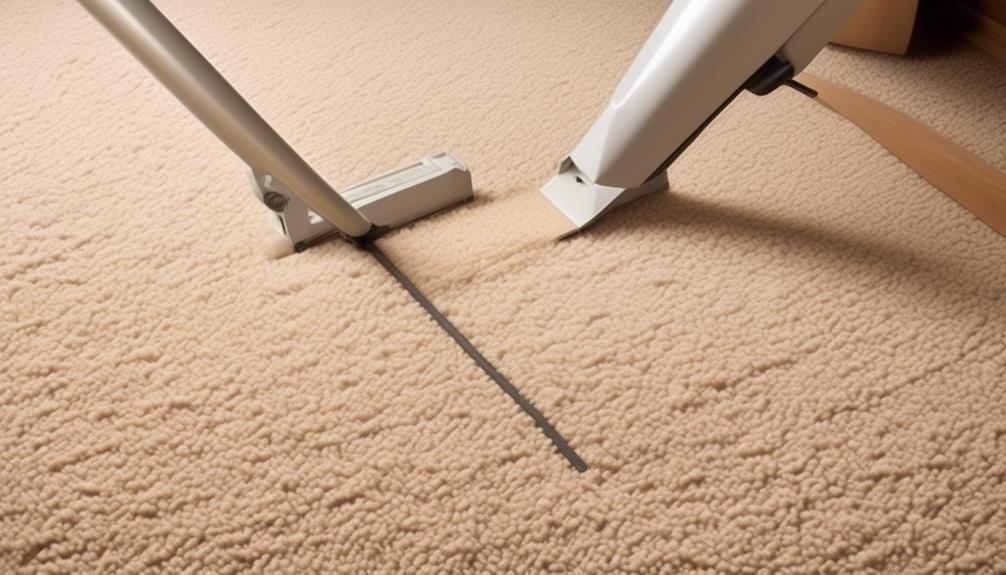
When it comes to replacing carpet, many individuals are often taken aback by the fact that the process goes beyond just removing the old carpet and installing the new one. There are numerous steps included in the replacement procedure, all of which play a role in the overall timeline.
From the initial preparation to the final finishing touches, understanding the various stages and how they impact the timeline can help in planning for this home improvement project. But just how long does it take to replace carpet? Let's explore the different factors that influence the timeline and the average duration for each step.
Key Takeaways
- Thoroughly evaluate flooring options for durability, maintenance, and aesthetic appeal before selecting a carpet replacement.
- Properly dispose of the old carpet, considering the environmental impact and exploring recycling options.
- Inspect and repair the subfloor before installation to ensure it is flat, even, and free of any issues that could affect the new carpet.
- Follow a timeline for the new carpet installation process, including thorough cleaning and drying of the subfloor, precise measurement and cutting of the carpet, and establishing a maintenance routine after installation.
Pre-Installation Preparation
Before beginning the replacement of carpet, it's essential to thoroughly prepare the area to ensure a smooth and successful installation process.
When considering flooring options, it's crucial to evaluate the various materials available and their suitability for the specific area where the carpet will be replaced. Factors such as durability, ease of maintenance, and aesthetic appeal should be carefully weighed against budget considerations.
We've found that hardwood, laminate, and luxury vinyl are popular alternatives to carpet, offering a diverse range of styles and price points to suit different budgets and preferences.
Proper planning and budgeting are vital, as they allow for the selection of the most suitable flooring option that meets both functional and aesthetic requirements. It's also essential to account for additional costs such as underlayment, installation materials, and professional labor if needed.
Carpet Removal Process
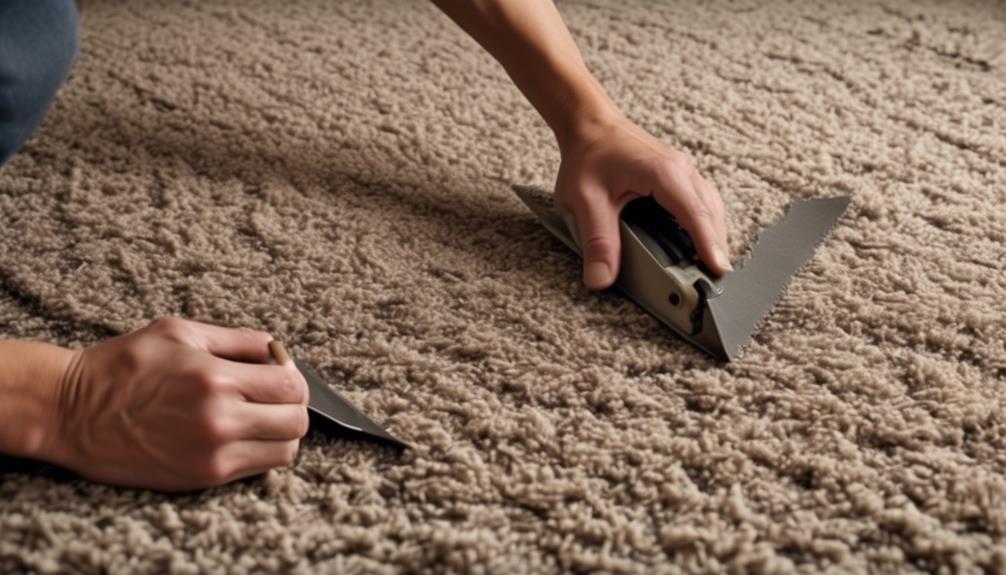
We begin the carpet removal process by carefully lifting and rolling the carpet, ensuring that any tack strips or adhesive are safely and thoroughly removed from the subfloor. This step is crucial to prevent damage to the subfloor and to ensure a smooth surface for the new carpet installation.
Here are some key aspects to consider during the carpet removal process:
- Proper disposal: Once the old carpet is removed, it's important to handle its disposal properly. This may involve recycling the carpet material or arranging for its proper disposal at a waste management facility. Proper disposal not only contributes to a cleaner environment but also ensures compliance with local regulations.
- Environmental impact: The removal of old carpet can have environmental implications, especially if it contains synthetic materials or hazardous substances. By considering the environmental impact of the removal process, such as the release of volatile organic compounds (VOCs) or the generation of waste, measures can be taken to minimize any negative effects on the environment.
- Recycling options: Exploring recycling options for the old carpet can be beneficial from both an environmental and a sustainability standpoint. Many carpet recycling facilities can process old carpet into new products, reducing the overall environmental impact of the removal process.
Careful consideration of these aspects can contribute to a responsible and environmentally conscious carpet removal process.
Subfloor Inspection and Repair
Upon inspecting the subfloor, it is imperative to meticulously assess for any signs of damage or irregularities that could impact the new carpet installation. Subfloor evaluation involves checking for any dips, humps, or squeaks, which may indicate structural issues that need to be addressed before laying new carpet. Additionally, moisture assessment is crucial to prevent mold and mildew growth, which can ruin the new carpet and pose health risks.
| Subfloor Evaluation | Moisture Assessment |
|---|---|
| Check for dips, humps, or squeaks. | Use a moisture meter to detect any excess moisture. |
| Inspect for signs of water damage or rot. | Look for discoloration or musty odors. |
| Ensure subfloor is flat and even. | Inspect the area around plumbing fixtures for leaks. |
Thorough subfloor inspection and repair are essential for ensuring the longevity and performance of the new carpet. Addressing any subfloor issues before installation can prevent costly and inconvenient problems in the future. Our experience and knowledge in subfloor assessment allow us to identify and rectify any issues, providing a solid foundation for the new carpet.
New Carpet Installation

After ensuring that the subfloor is free from any dips, humps, or moisture issues, the new carpet installation process can commence with confidence and precision.
When it comes to installing new carpet, it's crucial to follow a timeline that ensures a seamless transition from old to new. Here are the key points to consider:
- Preparation: Thoroughly clean the subfloor and allow it to dry completely before laying the carpet pad and new carpet. This step is essential for preventing mold and mildew growth under the new carpet.
- Precision Cutting: Carefully measure and cut the carpet to fit the room, ensuring a precise and professional finish. Proper cutting is crucial for a seamless and wrinkle-free installation.
- Post-Installation Care: Once the new carpet is in place, it's important to establish a routine for maintenance. Regular vacuuming and prompt cleanup of spills are essential for preserving the carpet's appearance and longevity.
Following these steps, the installation timeline can vary depending on the size of the area and the complexity of the project. However, with attention to detail and regular carpet maintenance, the investment in new carpet will provide comfort and aesthetic appeal for years to come.
Clean-Up and Finishing Touches
To ensure a pristine finish, the clean-up process should involve meticulously removing any carpet remnants, vacuuming the entire area, and inspecting for any imperfections or loose edges that require attention.
After the new carpet is installed, it's crucial to clean up any leftover debris or carpet scraps. This can be done by using a vacuum to thoroughly clean the entire area, ensuring that no remnants are left behind.
Next, a final inspection should be conducted to check for any imperfections or loose edges in the carpet. It's important to carefully examine the entire carpeted area to ensure that the installation is flawless. Any loose edges should be properly secured, and any imperfections should be addressed promptly to guarantee a polished final result.
Additionally, a thorough cleaning and inspection will provide peace of mind that the new carpet is in top-notch condition and that the installation process has been completed with the utmost attention to detail. These final clean-up and finishing touches are essential steps in achieving a professional and high-quality carpet replacement.
Frequently Asked Questions
Are There Any Health Concerns Associated With Old Carpet That Should Be Addressed During the Replacement Process?
When replacing old carpet, it's crucial to address potential health concerns, especially related to indoor air quality.
We've found that using sustainable materials can be a cost-effective option that also promotes better indoor air quality.
Old carpets can harbor allergens, mold, and other particles that can impact respiratory health.
How Can I Ensure That the New Carpet Installation Process Is Environmentally Friendly?
When ensuring an environmentally friendly new carpet installation process, we focus on using eco-friendly materials and sustainable installation techniques. This involves choosing carpets made from recycled or renewable materials, and utilizing low VOC adhesives.
Our experienced team ensures that the installation process minimizes waste and energy consumption. We prioritize eco-friendly practices to create a healthier indoor environment while maintaining the highest standards of quality and craftsmanship.
What Are the Best Ways to Maintain and Care for the New Carpet After Installation?
Maintaining cleanliness and preventing stains are crucial for new carpet care. We recommend regular vacuuming to remove dirt and debris, as well as using doormats to minimize tracking in of outside dirt.
For preventing stains, prompt spot cleaning is key, using a manufacturer-approved cleaner. Additionally, professional deep cleaning every 12-18 months can extend the carpet's lifespan.
These practices will help preserve the appearance and quality of your new carpet.
Are There Any Potential Hazards or Safety Precautions to Consider During the Carpet Replacement Process?
Potential hazards and safety precautions are crucial during carpet replacement. We've encountered health concerns from old carpet removal, like dust and mold exposure. Safety measures include proper ventilation and wearing protective gear.
Our experience emphasizes the importance of thorough cleaning and ensuring the space is safe for occupants. It's essential to be meticulous in addressing potential hazards and taking necessary safety precautions to create a healthy environment after carpet replacement.
How Can I Minimize the Disruption to My Daily Routine During the Carpet Replacement Process?
To minimize disruption to our daily routine during carpet replacement, we can opt for cost-effective solutions and quick installation methods.
Planning the replacement during a time when we're away, like a weekend or vacation, can help reduce impact.
Clearing the area beforehand and coordinating with the installers for efficient scheduling can also streamline the process.
Choosing low-pile carpets or carpet tiles can speed up installation, minimizing the time we're without access to the space.
– What is the Average Lifespan of Carpet Before Replacement is Necessary?
The average lifespan of a carpet varies depending on the quality and maintenance. According to the carpet replacement frequency guide, most carpets should be replaced every 5 to 15 years. Factors such as foot traffic and regular cleaning also impact the longevity of a carpet.
Conclusion
After completing the entire process, it typically takes about 3-5 days to replace carpet in an average-sized room. This includes pre-installation preparation, carpet removal, subfloor inspection and repair, new carpet installation, and clean-up.
On average, a professional carpet installer can replace carpet in about 250-300 square feet of space per day.
With proper planning and efficient work, your new carpet can be installed in no time.
- About the Author
- Latest Posts
Introducing Ron, the home decor aficionado at ByRetreat, whose passion for creating beautiful and inviting spaces is at the heart of his work. With his deep knowledge of home decor and his innate sense of style, Ron brings a wealth of expertise and a keen eye for detail to the ByRetreat team.
Ron’s love for home decor goes beyond aesthetics; he understands that our surroundings play a significant role in our overall well-being and productivity. With this in mind, Ron is dedicated to transforming remote workspaces into havens of comfort, functionality, and beauty.
Beginners Guides
The Best Time to Go on a Cruise for Perfect Weather
Sail through the maze of climate patterns to uncover the best times for perfect weather on a cruise, ensuring a memorable voyage awaits.

When it comes to choosing the best time to go on a cruise for perfect weather, it's like steering a maze of climate patterns to find that golden ticket. But fear not, as we have the compass to guide you in the right direction.
Understanding the seasonal nuances can make all the difference between a sun-kissed voyage and a rainy retreat. So, grab your sunscreen and pack your bags as we uncover the best times to set sail for idyllic weather conditions that will make your cruise a memorable experience.
Key Takeaways
- Caribbean cruises: December to mid-April for best weather conditions
- Alaskan cruises: Late June to mid-July for breathtaking landscapes
- Mediterranean cruises: April-May & September-October for ideal weather
- Hawaii cruises: Summer and fall months for dry weather and sunny skies
Ideal Months for Caribbean Cruises
For ideal weather conditions and a pleasant cruising experience in the Caribbean, consider booking your voyage between December and mid-April. During this period, the Caribbean boasts the best weather for cruises, with dry conditions and sunny skies prevailing. This stretch offers a fantastic opportunity to soak up the sun, enjoy water activities, and explore the stunning destinations in the region without the worry of rainstorms or excessive humidity.
Late summer into fall presents the cheapest time for Caribbean cruises, making it an excellent choice for budget-conscious travelers looking to experience the beauty of the Caribbean without breaking the bank. By opting for a cruise during this period, you can take advantage of lower prices and fewer crowds while still enjoying the warm waters and picturesque landscapes the Caribbean is known for.
Avoiding the peak season from December to April is advisable for those seeking a more peaceful and wallet-friendly experience. Sailing in late June through August allows travelers to steer clear of the crowds, particularly families on vacation during school breaks, making for a more relaxed and intimate cruise experience.
Optimal Weather for Alaskan Cruises

To maximize your Alaskan cruise experience, targeting late June through mid-July guarantees ideal weather conditions for enjoying the breathtaking landscapes and wildlife sightings in the region. During mid-July, you can witness the spectacular salmon run season, where various wildlife, including bears and bald eagles, gather along the rivers for this perfect phenomenon.
Late August to mid-September is another excellent window for Alaskan cruises, offering pleasant weather and often lower prices as it marks the end of the peak season. If your focus is on spotting whales, August is the prime time for your cruise, as these majestic creatures are commonly seen during this period.
For those seeking a balance between affordability and decent weather, mid-May to early June also presents a good opportunity to explore Alaska on a cruise. Keep these ideal weather periods in mind when planning your Alaskan adventure for an unforgettable experience.
Perfect Seasons for Mediterranean Cruises
April-May and September-October stand out as the prime seasons for Mediterranean cruises, offering ideal weather conditions and fewer crowds for a delightful experience exploring the region. During these shoulder seasons, the Mediterranean boasts milder temperatures and a more relaxed atmosphere compared to the peak tourist season in July and August. Traveling in April or May allows for pleasant sightseeing without the sweltering heat or overwhelming crowds. Likewise, September and October provide a serene setting for cruising with comfortable weather and less tourist congestion.
Additionally, prices for Mediterranean cruises tend to be lower from May to November, making it a cost-effective option for travelers seeking a budget-friendly voyage. Consider booking a Mediterranean cruise in May 2024 with MSC starting at $499/person to enjoy the perfect blend of favorable weather and affordable prices.
- Ideal weather conditions
- Fewer crowds
- Milder temperatures
- Lower prices during shoulder seasons
- Peak tourist season in July and August
Prime Time for Hawaii Cruises
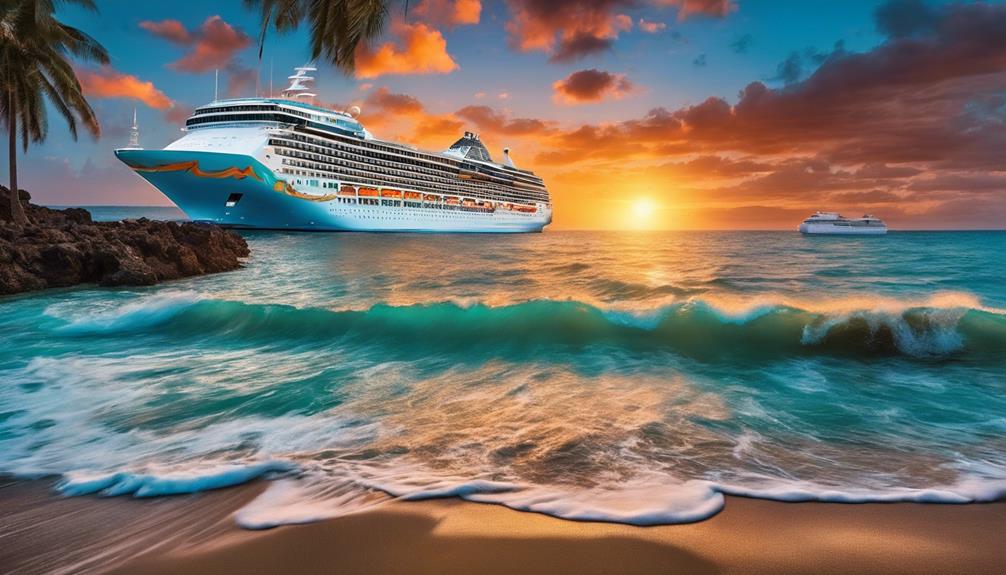
The best time to start on a Hawaii voyage is usually during the summer and fall months when the weather is dry and the skies are sunny. Hawaii cruises are particularly rewarding from mid-September through October, offering ideal conditions for a memorable experience. If you're interested in whale watching, the period from late October through May is perfect for spotting these majestic creatures in their natural habitat. During this time, the weather remains pleasant, with minimal rainfall from August through October, ensuring a smooth sailing experience.
For travelers seeking a cost-effective option, January through March can be a good time to contemplate a Hawaii cruise, although weather conditions may vary slightly. These months often offer competitive pricing and fewer crowds, allowing you to enjoy the beauty of Hawaii at a more relaxed pace. Whether you're into adventure, relaxation, or simply soaking in the stunning scenery, a Hawaii cruise during the summer and fall months promises an unforgettable journey.
Best Weather for Australia & New Zealand Cruises
For those considering voyages beyond Hawaii, exploring the best weather for Australia & New Zealand cruises becomes paramount, especially as these regions offer unique experiences throughout the year. When planning your cruise to Australia and New Zealand, keep in mind the following key points for an enjoyable voyage:
- November to March: This period offers warm temperatures and sunny weather in major ports like Sydney, making it the best time to go on a cruise in Australia & New Zealand.
- Early February to mid-March: Experience the warmest weather in Australia during these months, ensuring a comfortable cruise.
- New Zealand's Climate: With a temperate climate, layering is recommended for cruises throughout the year to stay comfortable.
- Consider Off-Peak Months: October, November, or April can provide discounted fares in Australia outside the peak season, allowing for savings on your cruise.
- Reversed Seasons: Australia and New Zealand have reversed seasons compared to the northern hemisphere, influencing the ideal timing for a cruise in these regions.
Planning your trip around these factors will help you make the most of your cruise experience in Australia and New Zealand.
Conclusion
To guarantee the best time to go on a cruise for perfect weather is essential for a memorable and enjoyable experience. By researching the ideal months for different regions like the Caribbean, Alaska, Mediterranean, Hawaii, Australia, and New Zealand, you can secure smooth sailing and sunny skies.
Don't just take our word for it, investigate the truth of this theory yourself and discover the magic of cruising in ideal weather conditions.
- About the Author
- Latest Posts
Introducing Ron, the home decor aficionado at ByRetreat, whose passion for creating beautiful and inviting spaces is at the heart of his work. With his deep knowledge of home decor and his innate sense of style, Ron brings a wealth of expertise and a keen eye for detail to the ByRetreat team.
Ron’s love for home decor goes beyond aesthetics; he understands that our surroundings play a significant role in our overall well-being and productivity. With this in mind, Ron is dedicated to transforming remote workspaces into havens of comfort, functionality, and beauty.
Beginners Guides
The Best Time to Cruise for Budget-Friendly Deals
Fulfill your wanderlust dreams without draining your wallet by learning the key to scoring budget-friendly cruise deals.
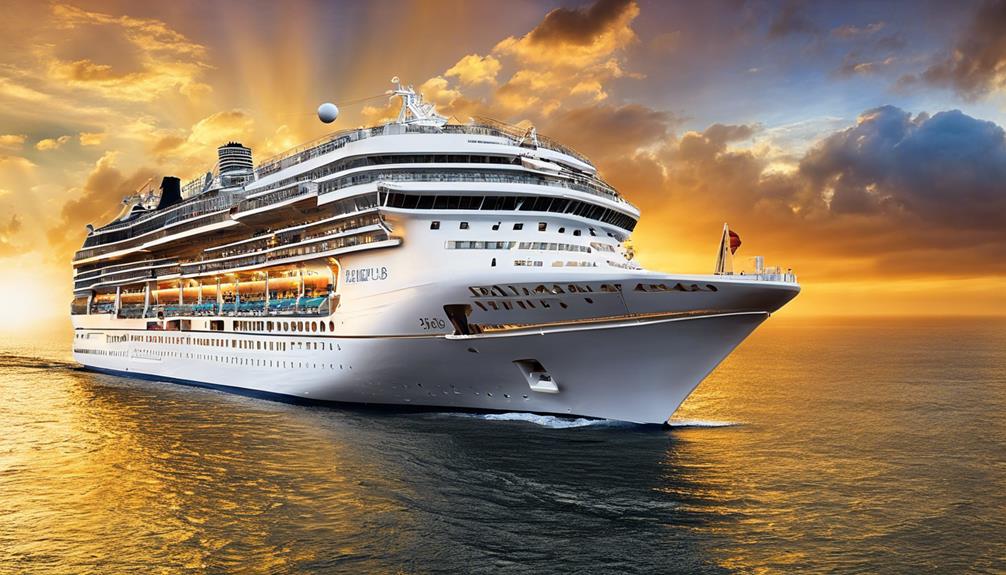
When it comes to finding budget-friendly cruise deals, timing is key. Imagine setting sail on the crystal blue waters of the Caribbean or exploring the stunning glaciers of Alaska without breaking the bank.
There's a specific window of opportunity that savvy cruisers keep an eye on to secure the best rates and save some serious cash. But how do you know when to book your next adventure to make the most of your budget?
Let's uncover the secrets behind scoring the ultimate cruise deals and making your dream vacation a reality.
Key Takeaways
- Booking during wave season in January to March ensures budget-friendly deals.
- Monitoring prices post-booking for drops leads to potential refunds or upgrades.
- Repositioning cruises in spring and fall offer cost-effective options.
- Leveraging loyalty programs maximizes savings for affordable cruising.
Ideal Seasons for Budget-Friendly Cruises
When seeking budget-friendly cruise deals, timing plays an important role in securing the best value for your money. Shoulder seasons such as September, October, and early December present excellent opportunities for travelers looking for cheaper fares. These off-peak times often offer discounted rates and fewer crowds, making it an ideal choice for budget-conscious individuals.
Additionally, booking during wave season in January and February can lead to significant discounts and promotions, maximizing savings on your cruise vacation.
Repositioning cruises during spring and fall are another fantastic option for savvy travelers seeking affordable deals. These cruises often provide cost-effective choices as cruise lines move their ships between different regions.
Avoiding major holidays and school breaks is also key to securing cheaper cruise fares and ensuring a more relaxed cruising experience. Moreover, sailing from Florida during off-peak times can offer a wide range of options and better deals for those looking to save on their cruise adventures.
Strategies for Booking Affordable Cruises
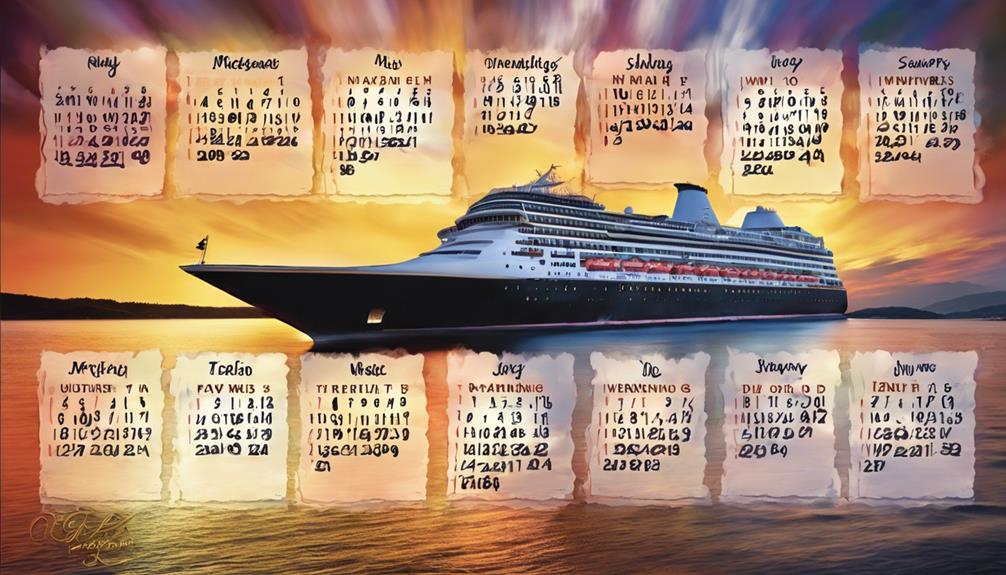
To secure the best deals on cruises, it's important to employ strategic booking approaches that maximize cost savings and value for your vacation. When aiming for budget-friendly cruise deals, consider the following strategies:
- Booking in Advance: Securing your cruise early, especially during wave season from January to March, can lead to lower rates and additional benefits.
- Monitoring Fare Changes: Keep an eye on fluctuating fares and be ready to book when prices drop to secure the best deal.
- Being Flexible with Travel Dates: Flexibility can be key in finding affordable cruise options, as adjusting your travel dates slightly can result in significant savings.
- Considering Repositioning Cruises: Exploring repositioning cruises or sailing during shoulder seasons can offer unique routes and discounted prices.
- Utilizing Loyalty Programs and Off-Peak Times: Take advantage of loyalty programs, monitor price drops, and consider traveling during off-peak times to maximize your savings on cruise vacations.
Best Times to Score Cruise Deals
During wave season from January to March, travelers can capitalize on the best times to secure budget-friendly cruise deals. Booking well in advance is key to snagging the most favorable timing and rates for your cruise.
Additionally, considering repositioning cruises during the spring and fall can offer discounted prices, making them a great option for those seeking budget-friendly deals. It's also advisable to keep an eye out for price drops even after booking, as this could potentially lead to refunds or upgrades for your cruise experience.
Leveraging loyalty programs or memberships can grant you access to exclusive discounts and savings on your upcoming cruise. By being proactive and strategic in your approach to booking and monitoring deals, you can maximize your chances of finding the best cruise deals that align with your budget and preferences.
Timing Tips for Budget-Friendly Cruises
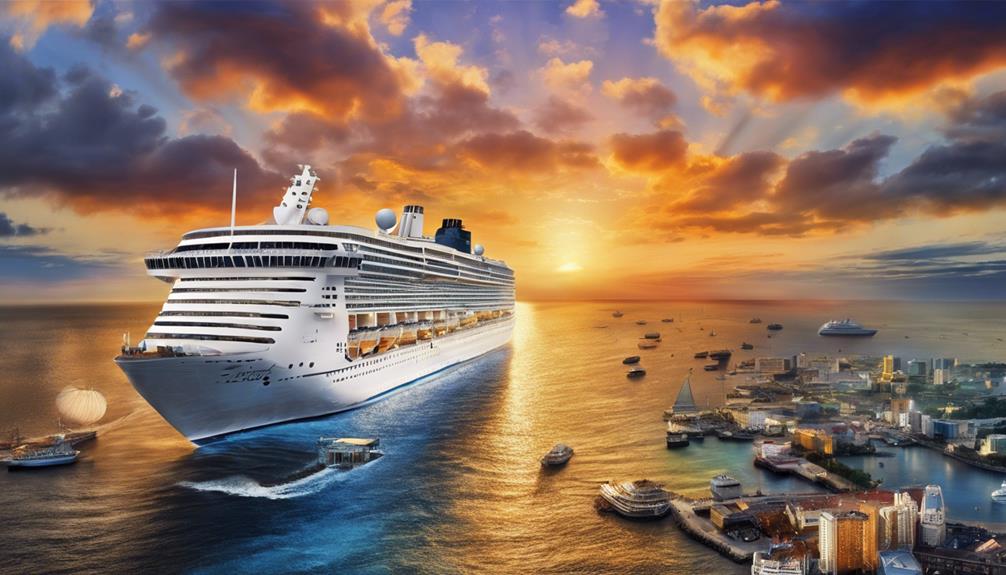
Let's explore practical strategies for maximizing your savings on budget-friendly cruises through strategic timing tips. When aiming to secure the best cruise deals that align with your budget, consider the following insights:
- Booking in Advance: Take advantage of wave season from January to March to lock in lower rates and secure desirable cabin options.
- Monitoring Prices: Keep an eye on price drops even after booking to potentially benefit from refunds or upgrades, enhancing your overall cruise experience.
- Loyalty Programs: Utilize loyalty programs or memberships to access additional discounts and exclusive perks, making your budget-friendly cruise even more cost-effective.
- Nearby Ports: Opt for cruises departing from nearby ports to save on airfare costs, enabling you to allocate more of your budget towards onboard activities and excursions.
- Discounts Galore: Embrace the array of discounts available during wave season and beyond, ensuring that you snag the best possible deal for your budget-friendly cruise adventure.
When to Book for Cruise Savings
Securing cruise savings hinges on strategic timing and proactive booking practices. To find the best deals, consider booking during wave season from January to March when many cruise lines offer enticing discounts.
Booking early not only guarantees better rates but also provides a wider selection of cabin choices. Keep an eye out for fare changes even after booking, as price drops may occur, presenting an opportunity for additional savings.
While waiting for last-minute deals can sometimes lead to the cheapest rates, this approach often comes with limited cabin availability. To stay informed about price fluctuations, utilize tools like the Shipmate app and Cruise Critic for efficient monitoring.
Conclusion
To summarize, cruising during the off-peak season can help us save some serious dough. Booking early during wave season is key to scoring those sweet deals.
So, let's set sail and make some memories without breaking the bank. Remember, early bird gets the worm – or should I say, the cruise discount!
- About the Author
- Latest Posts
Introducing Ron, the home decor aficionado at ByRetreat, whose passion for creating beautiful and inviting spaces is at the heart of his work. With his deep knowledge of home decor and his innate sense of style, Ron brings a wealth of expertise and a keen eye for detail to the ByRetreat team.
Ron’s love for home decor goes beyond aesthetics; he understands that our surroundings play a significant role in our overall well-being and productivity. With this in mind, Ron is dedicated to transforming remote workspaces into havens of comfort, functionality, and beauty.
Beginners Guides
Best Time to Go on an Alaskan Cruise for Wildlife Watching
Get ready to discover the optimal time for wildlife enthusiasts to embark on an Alaskan cruise – the ultimate season for extraordinary encounters awaits!

One could contend that any time of year is fitting for an Alaskan cruise, but if you genuinely want to maximize your wildlife watching opportunities, timing is key.
While many months offer glimpses of nature's wonders, there is a particular period that stands out above the rest.
Join us as we explore the intricacies of the Alaskan wilderness and uncover the secrets of when to set sail on a journey that promises unforgettable encounters with some of the most magnificent creatures on earth.
Key Takeaways
- Prime months for wildlife viewing in Alaska are May, June, and September.
- Peak whale watching season is from mid-June to August.
- Best time for bear spotting is between July and early September.
- Ideal months for bald eagle sightings in southeast Alaska are from May to September.
Prime Months for Wildlife Viewing
During the prime months of May, June, and September, Alaska offers the best conditions for wildlife enthusiasts to observe a diverse array of animals in their natural habitats. June marks the beginning of summer, a time when the landscape comes alive with the sights and sounds of wildlife.
July and August are ideal for witnessing brown bears fishing for salmon and catching glimpses of majestic moose roaming through the wilderness. These months provide ample opportunities for up-close wildlife viewing experiences, especially during the salmon run when bears gather along the rivers to feast.
As the summer changes into September, visitors can look forward to spotting humpback whales during their annual migration, as well as witnessing the spectacular spawning salmon and caribou herds moving across the land. The shoulder seasons offer a unique chance to explore Alaska inside and out, with fewer crowds and mosquitoes, making it an ideal time for wildlife enthusiasts to immerse themselves in the natural beauty of the region.
Peak Whale Watching Season
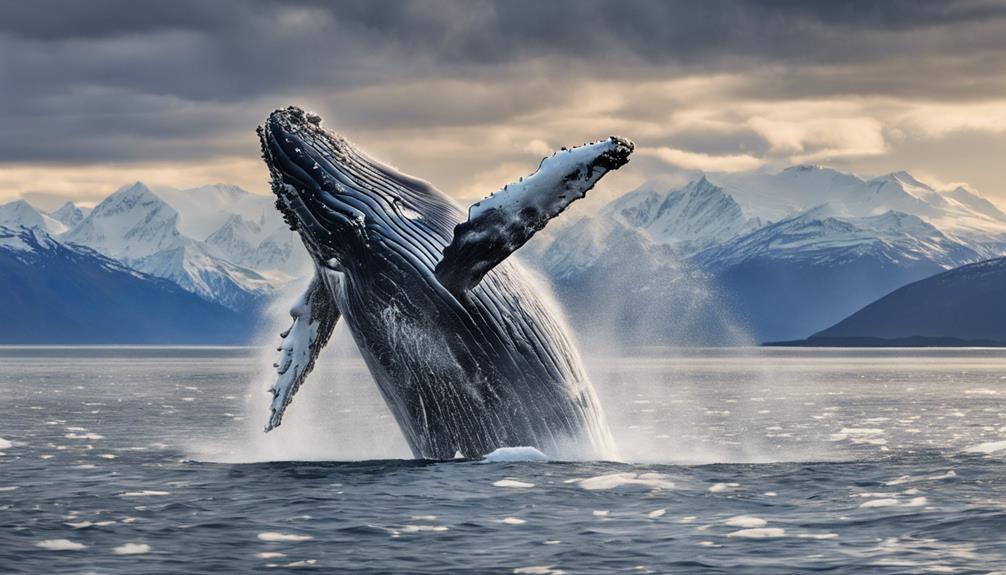
In the peak whale watching season in Alaska, which typically spans from mid-June to August, enthusiasts have the best opportunities to witness humpback whales and other species in their natural habitat. Humpback whales are commonly sighted during the summer months as they feed on small fish and krill.
Killer whales, also known as orcas, are best spotted in May and June near Ketchikan, Juneau, and Seward, hunting for seals and other marine mammals. Grey whales migrate to southern Alaska in late spring, showcasing their impressive breaching behaviors.
Blue whales, the largest animals on Earth, may be seen in July and August, traveling through Alaskan waters in search of food. Whale sightings can vary depending on the specific month of your Alaskan cruise, so choosing the right time within the peak season is important for maximizing wildlife watching opportunities while sailing through these majestic waters.
Best Time for Bear Spotting
Ideally situated between July and early September, the peak time for bear spotting in Alaska coincides with the salmon influx that attracts these magnificent creatures to the creeks and streams of the region. During this period, Grizzly bears can be observed in their natural habitat, offering a thrilling experience for wildlife enthusiasts. Royal Caribbean Cruise Tours in Alaska often include bear viewing excursions, enhancing the opportunity to witness these powerful animals up close. For best bear sightings, consider visiting during the salmon run in July, a time when bears are actively hunting for fish in creeks and streams, particularly in locations like Ketchikan. Alaska's diverse landscapes and ecosystems provide ample opportunities for bear viewing, from observing black bears to encountering majestic brown bears. Whether through guided tours or remote float plane trips, Alaska offers a range of experiences to witness these iconic creatures in their element.
| Best Time for Bear Spotting | |
|---|---|
| July | Salmon run |
| Early September | Grizzly bears |
| Creeks | Streams |
| Ketchikan | Royal Caribbean Cruise Tours |
Ideal Months for Eagle Sightings

The peak months for perfect bald eagle sightings in southeast Alaska are from May to September. During these months, as part of an Alaska cruise, birdwatching enthusiasts can witness the majestic bald eagles in their natural habitat. Southeast Alaska, home to around 30,000 bald eagles, offers ample opportunities for wildlife watching, especially near bodies of water where eagles are commonly spotted.
The Sitka Cultural Discovery excursion is a great way to observe bald eagles up close, as they're frequently seen near streams and bodies of water. With approximately 470 bird species in the region, including the iconic bald eagle, Southeast Alaska provides a diverse birdwatching experience for nature lovers.
Whether soaring through the skies or perched on branches overlooking the water, bald eagles are a common sight throughout the summer months in this pristine Alaskan wilderness. For those seeking unforgettable eagle sightings and a chance to immerse themselves in Alaska's rich wildlife, visiting during the peak months offers an unparalleled birdwatching experience.
Optimal Time for Otter Encounters
Best timing for observing otters in Alaska ranges from early spring through the end of July. During this period, the chances of encountering these enchanting creatures are at their peak. Here are some key points to keep in mind for prime otter encounters during your Alaskan cruise:
- Steller sea lions: While otters are more prevalent during spring and early summer, Steller sea lions can be spotted year-round in Alaska. Keep an eye out for these majestic marine mammals as they often share habitats with otters.
- Streams and creeks: Otters are frequently seen near streams and creeks, making these areas prime locations for wildlife watching. Cruise along these waterways to increase your chances of a memorable otter sighting.
- Wildlife tours: Participating in wildlife tours in Alaska can enhance your otter encounters. These tours often provide opportunities to get up close to Steller sea lions, with otters sometimes making surprise appearances alongside them.
- Sea otters near the ocean: Whether near the ocean or inland water bodies, otters are adaptable creatures that thrive in various environments. Keep a lookout for these playful animals during your Alaskan cruise for a truly immersive wildlife experience.
Conclusion
To sum up, our investigation confirms that the best time to go on an Alaskan cruise for wildlife watching is indeed during the peak season of July.
The abundance of wildlife sightings, perfect weather conditions, and increased chances of spotting bears, whales, eagles, otters, and other fascinating creatures make July the ideal month for an unforgettable Alaskan wildlife experience.
Don't miss out on this prime opportunity to witness the wonders of nature in their natural habitat.
- About the Author
- Latest Posts
Introducing Ron, the home decor aficionado at ByRetreat, whose passion for creating beautiful and inviting spaces is at the heart of his work. With his deep knowledge of home decor and his innate sense of style, Ron brings a wealth of expertise and a keen eye for detail to the ByRetreat team.
Ron’s love for home decor goes beyond aesthetics; he understands that our surroundings play a significant role in our overall well-being and productivity. With this in mind, Ron is dedicated to transforming remote workspaces into havens of comfort, functionality, and beauty.
-

 Decor4 days ago
Decor4 days agoMaximalist Decor Explained: Embrace More Style
-

 Vetted4 weeks ago
Vetted4 weeks ago15 Best Drip Irrigation Systems to Keep Your Garden Thriving
-

 Vetted1 week ago
Vetted1 week ago15 Best Foot Massagers for Neuropathy to Soothe Your Feet and Relieve Discomfort
-

 Vetted2 weeks ago
Vetted2 weeks ago15 Best Sports Laundry Detergents for Keeping Your Activewear Fresh and Clean
-

 Vetted2 weeks ago
Vetted2 weeks ago15 Best Tall Toilets for Seniors That Combine Comfort and Safety
-

 Vetted3 weeks ago
Vetted3 weeks ago15 Best Dish Scrubbers to Keep Your Kitchen Sparkling Clean
-

 Decor3 weeks ago
Decor3 weeks agoWhat Is Eclectic Home Decor
-

 Vetted15 hours ago
Vetted15 hours ago15 Best Organic Pest Control Solutions for a Naturally Pest-Free Home

























